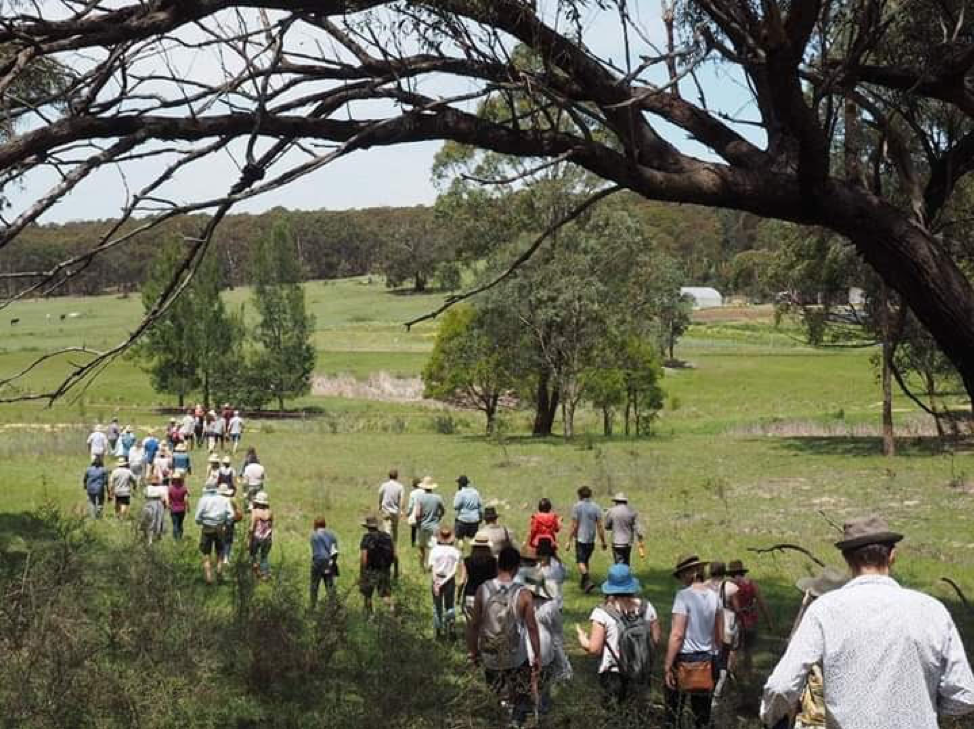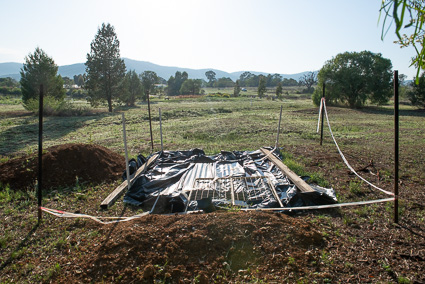Mark and Bjorn are developing an on-farm solar energy project with horticulturalists Erika Watson and Hayden Druce of Epicurean Harvest (in Hartley). After meeting on the farm the four of them have exchanged some exciting ideas via email which we really needed to share with the world… In this post we have included some pictures from Epicurean Harvest’s November ‘I’ll be damned! farm resilience’ fundraiser event, when they opened their gates to a couple of hundred people who were treated to food, tours, music and talks. As a result they are well on their way to being able to fund the installation of some P.A. Yeomans-style keyline water conservation and irrigation infrastructure on their farm in 2019. Brilliant.
This is Erika
Email 1 - Mark writes…
…We are keen to start throwing some ideas back and forth with some of the concepts we were talking about on our visit. Ideas around how to be more creative in re-thinking the ways we move water around a property and what unconventional ways we can use energy that is self sufficient. And of course how to make it look amazing!
In our meeting we went down a few paths not limited to solar powered little buggies that transport hose and pump water around the paddock. We discussed the ideas of retractable dam covers and floating solar. We played with the concept of the whole farm being one big energy producing entity and how to relate that concept into an artwork.
Let us know some of your thoughts, also if you'd still like to work with us on this? Where you'd like to see it go and how it can benefit the farm?
Email 2: Erika writes…
…Our ideas are obviously coming from our own context, but applicable to the exciting movement happening in the agricultural space. We are also 2 people with science degrees and creative backgrounds (Hayden music, me painting).
After you visited we went though in more detail the ideas we had thrown out there in the initial email. With a bit of space we have had more thoughts on those and the applicable nature for wider uptake as an artistically beautiful and agriculturally functional piece of solar science.
Below I have fleshed out thoughts/concepts more, and knowing you don't have a trillion dollar budget, aimed high with the idea of concepts translated into more financially achievable outcomes.
Floating Panels:
We discussed the dam and water (obviously our biggest issue and ongoing threat to livelihood). We aim to have the dam in place/built by February. If the panels went over this, we were thinking instead of floating it would be better to be a shelter. Floating as we mentioned would block air flow and light to the dam, affecting biology, also the surface would fluctuate with rainfall or use and perhaps be problematic for panels resting in the water’s surface. A structure built over the dam or part of the dam, perhaps to look like carved tree trunks or woven from materials (thinking of your bamboo Mark, but perhaps would need to be in metal in the dam then to wood if needed and the garden by the bay in Singapore), panels as leaves/canopy. Functionally this would reduce evaporation, still allow light through for dam life, and contribute to farm power needs. The tree/s a direct relationship to real trees/plants, photosynthesis and power of solar energy. The trees that were in the water (ie "planted" at the bottom of the dam), would have to go in, at least in part, before it filled up... its highly unlikely we would empty it to do the project, I'm sure you totally understand that! This sounds epic, Hahaha! But thought I'd flesh out what I can see on this end. This would be beneficial to our farm and dam project, but also to many farmers, who look to bore/groundwater as a source of irrigation as it doesn't evaporate... until you use it. We don't want to use groundwater, water in the ground/soil is the best place for it to be! Taking it up, throws it into the atmosphere, and moves it into the different water cycles around the planet. Water vapour contributes to 60-85% of the greenhouse effect. Workshops/engagements could be on photosythesis and photovoltaics, water cycles, carving, weaving, structural integrity...
Solar Powered Buggy:
We move cows/livestock almost daily or sometimes faster (depends on pasture quality etc) to enable grass to grow, and exudates to pour into the soil, improving organic matter. Many farmers moving towards regenerative agriculture do this, and a big blockage for uptake of these methods is the labour involved. That of carrying and moving fencing and watering infrastructure. An amazing designed "buggy" that holds and moves an IBC (1000L) of water, a water trough, stores fencing equipment (lightweight) and acts as a remote energiser for the fencing would be AMAZING. Obviously powered by solar. It would be super cool if it was remote controlled. This would suit pastured poultry, small herds of livestock suck as goats, sheep and even cows. This concept would have to be upscaled to apply to larger farmers with larger numbers of livestock. As an artwork, it would be up to design to translate the multifunctional coolness of something like this (i'm kinda seeing some sort of kinetic sculpture, even steam punk thing or a even streamline and sleek, or totally made of recycled materials to translate ease of uptake). Solar energy of course feeding the freedom of regenerative farming. Workshops/engagements can be on art as kinetic multifunctional use, solar energy, animals are part of a sustainable landscape...
Whole Farm Solar Energy:
I had the idea of what I was calling ribbons on the contour. Below the drainages cut for the dam (on contour), this is where forestry can take place and watered passively but instead of planting trees (a time vs wow factor to consider), a landscape sculpture that, like contour forestry, is below the dam drainage contours, built as a long tube (perhaps only needs to be 30cm tall?), woven out of logs, sticks, branches, filled with composted/ing materials and seed bombs of grasses, herbs, forbs, etc, faster growers than trees (which can also go in, but later in succession – also an important concept in regenerative farming). Increasing the biodiversity, solar harvest and a whole farm approach to sculpture. Workshops/engagements can be on biodiversity and ecosystem processes, photosynthesis and solar, sculpture across landscape...
This is Hayden
Email 3: Mark writes…
Erika! Awesome.
Floating Panels:
This is cool, bamboo would be great for the canopy, but it doesn’t do so well in direct sunlight for long. I’ve attached a photo of a project I did in Larjamanu where we wove disused aluminium cables from power lines. I can’t stop thinking Kinetic sculpture and maybe the solar power lowers the canopy in during the sunniest times of the day and opens it back up later when the sun goes away. Also floating barges are relatively simple to make, and don’t need to cover the whole space but might just float about. Plus they make really interesting platforms for sculptural work.
Solar powered Buggy.
The more I think about this the more I feel like farmers are just going to be like, well why not just put the IBC on a trailer and tow it around. Also it keeps on feeling like a ‘start up’ idea rather than a creative project. What do you guys think? BUT there are still creative solutions to this problem that would be really fun to play with. These sprinkler tractors https://www.youtube.com/watch?v=eTsEzqwjS0I (video complete with inspiring music) I was talking about in our meeting the other day, I’m thinking of as a fun model to scale up… not sure yet how useful it would be but it would be fun.
Whole Farm Solar.
Yeah this is great, this to me is a great spot to use woven bamboo, and let it naturally decompose once the growth around it gets thick enough.
Your enthusiasm is awesome and its contagious!
Lets keep chatting!
Email 4: Bjorn writes…
My thoughts at the moment are that the solar over dam idea sounds most practical. I really love the buggies, but agree it's kinda #startup. Floating solar is generally seen as a pain not worth the effort in the industry, so using the space of the dam without using floats and while respecting the solar requirements of the water would be really neat.
Looking forward to see where we can go with the next development!





























